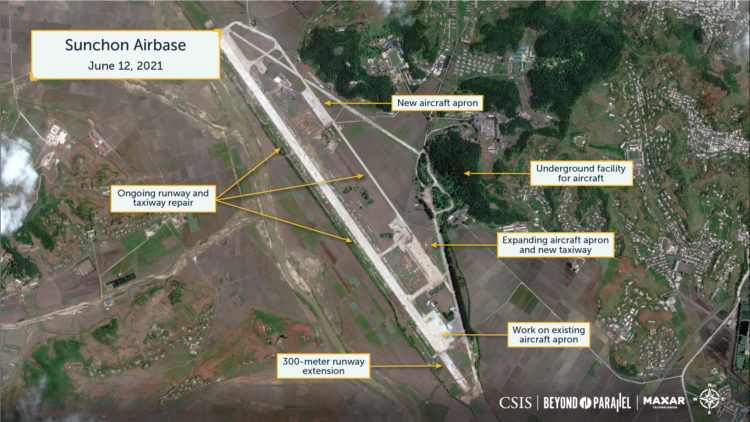
North Korea Upgrades Sunchon Airbase
This post was updated on July 15, 2022.
Key Findings
- Recent satellite imagery provides details into major maintenance and expansion at the Sunchon Airbase, which houses some of North Korea’s most modern and capable military aircraft in the Korean Air and Air Defense Force (KPAF)’s inventory.
- The first observed phase of the Sunchon maintenance and expansion project began sometime between April 11 – 14, 2021, when the Su-25 ground attack aircraft and the MiG-29 fighter aircraft were redeployed to different bases. This is highly suggestive of a far higher level of flight readiness than is normally attributed to these units, although this does not necessarily equate to combat readiness.
- The timing of the project and its associated aircraft movements were apparently designed to coincide, in part, with the KPAF annual summer training cycle, when KPAF aircraft are redeployed for flight training and to test operational readiness.
- Other maintenance and expansion work at the Airbase include additions and improvements to the runways, taxiways, and aircraft apron.
- When completed, the runway repair and extension efforts will not only improve the conditions of the runway and taxiways at the airbase, but also provide for a safer operating environment, additional parking space for aircraft, greater run-out for landing aircraft, and accommodation for more heavily loaded or larger aircraft.
Following up on a recent report by Joseph Dempsey at IISS covering various North Korean Air and Air Defense Force (KPAF) developments, recent Maxar satellite imagery provides an opportunity to add details to North Korea’s major maintenance and expansion project at the Sunchon Airbase in Pyongan-namdo (South Pyongan Province).1
The Sunchon Airbase (39.412031, 125.89069) is a major KPAF base subordinate to KPAF headquarters and is home to Unit #1017, which includes two air regiments equipped with Su-25K/UBK ground attack aircraft and MiG-29B/SE/UB fighters.2 Despite their age, these are some of the most modern and capable aircraft in the KPAF’s inventory.
The first observed phase of the Sunchon maintenance and expansion project began sometime between April 11–14, 2021, when the base’s Su-25K aircraft were redeployed to Kaechon Airbase (39.752859, 125.901374) 38 kilometers to the north and the MiG-29 aircraft redeployed to the Pukchang Airbase (39.504614, 125.964610) 12 kilometers to the northeast.3 As also noted by Joseph Dempsey, what is notable about this movement is that all MiG-29 and Su-25 aircraft known to be based at Sunchon were flown out to different bases.4 This is highly suggestive of a far higher level of flight readiness than is normally attributed to these units, although this does not necessarily equate to combat readiness.5


The timing of the project and its associated aircraft movements were apparently designed to coincide, in part, with the KPAF annual summer training cycle (June to mid-September).6 During the past 20 years, the KPAF has frequently used the period between the end of the winter training cycle and the summer training cycle to undertake major redeployments of KPAF aircraft for flight training and to test operational readiness.7
Work on the main runway was first noted on April 19, 2021, when large piles of gravel and sand were distributed on and alongside the main runway and taxiways. This work appears to have been centered primarily upon repairing damage to and improving the shoulders of the runway and taxiways, and on addressing some drainage problems. A runway extension project was also begun at the southern end of the runway.

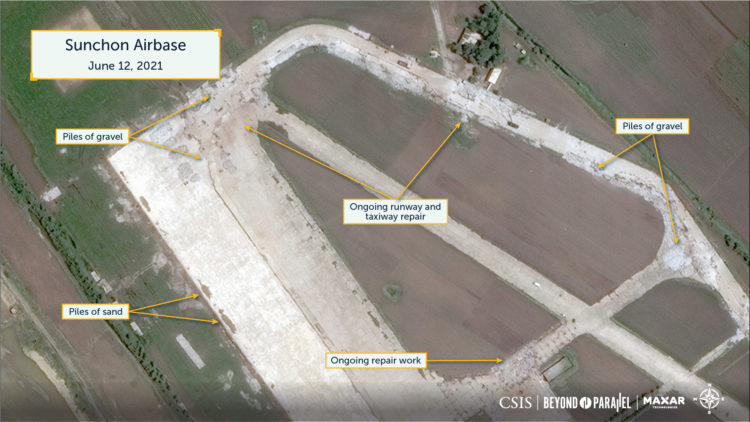
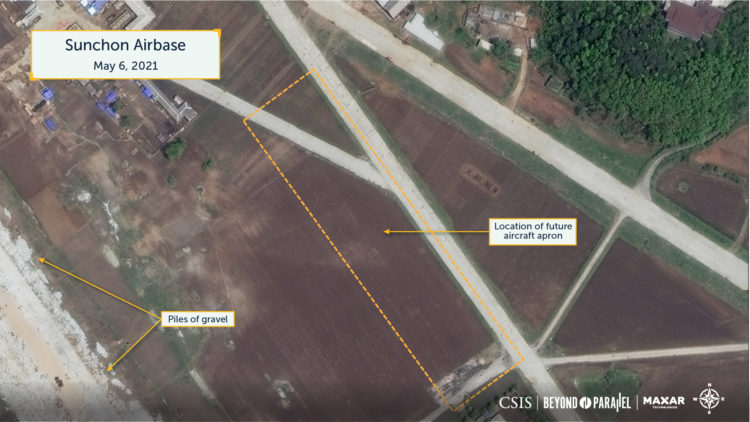
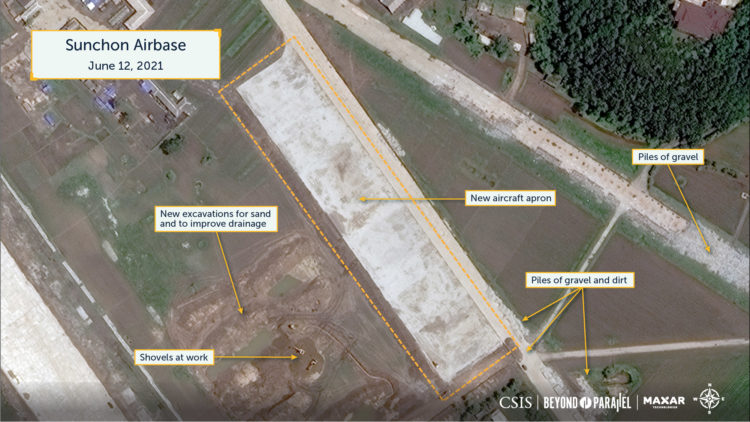
By June 12, this work had apparently proceeded rapidly and expanded to include the addition of a new taxiway, a large aircraft apron on the northeast end of the airbase, and what appears to be an expansion of the existing aircraft apron near the southeast end of the airbase. The runway extension project appears as if it will add approximately 300 meters, bringing the total length to 2,800 meters. Improvement and minor rerouting of drainage around the airbase is also noted.
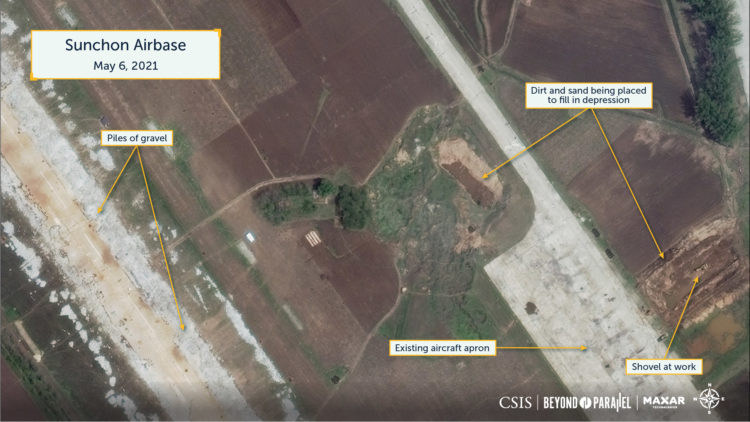

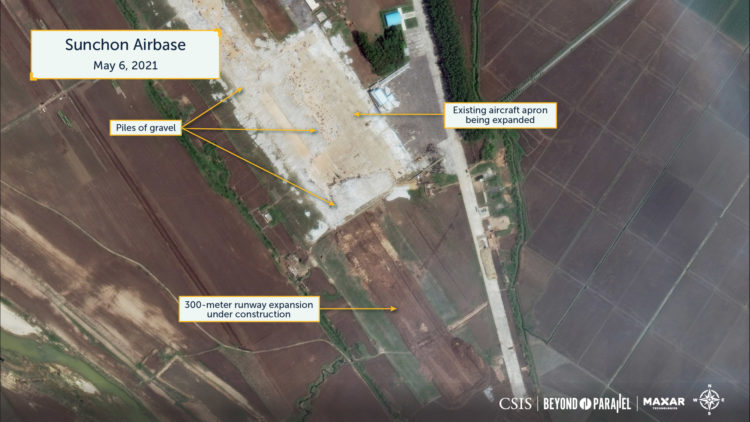
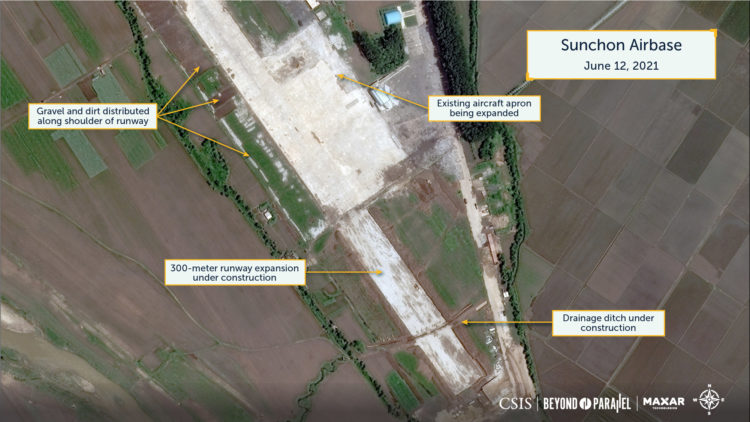
Notably, the June 12 image shows that the various control towers, radars, support buildings, housing areas, and etc. have remained unchanged.
Aside from work on the taxiways around it, and the presence of some construction supplies and equipment, the large aircraft underground facility (hanger) under the hill mass at the center of the airbase appears to have remained largely unchanged so far.
The runway repair and extension efforts, when completed, will not only improve the conditions of the runway and taxiways at the airbase, but also provide for a safer operating environment, additional parking space for aircraft, greater run-out for landing aircraft, and accommodation for more heavily loaded or larger aircraft.

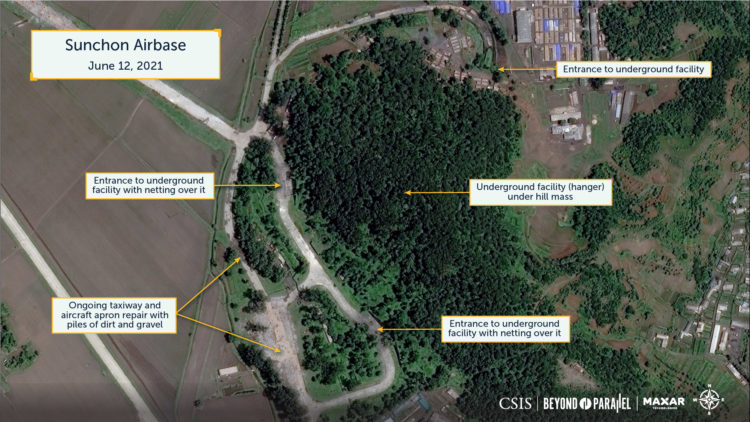
References
- Dempsey, Joseph. “The North Korean Air Force: Fated to Have an Eternal Aircraft Inventory?,” IISS, June 18, 2021, https://www.iiss.org/blogs/military-balance/2021/06/north-korea-air-force-inventory. The airbase is also known as the Sunch’ŏn Airbase or, formerly as the P’yŏng-ni Airbase. P’yongan-namdo is also known as P’yŏngan-namdo or P’yŏnganam. ↩
- The “UB” designation represent the trainer version of the aircraft. Author interview data. ↩
- The Pukchang Airbase is home to the 60th Air Regiment equipped with MiG-29ML/UB fighter aircraft. The Kaechon Airbase is home to the 35th Air Regiment equipped with MiG-19, MiG-15U, and MiG-17U fighters. “U” or “UB” being the trainer version of these aircraft). ↩
- See “The North Korean Air Force: Fated to Have an Eternal Aircraft Inventory?” ↩
- Author interview data. ↩
- The late-summer and fall annual training cycles also dedicate time to harvesting and preparations for winter. Author interview data. ↩
- Author interview data. ↩

